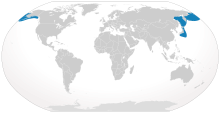| North Pacific right whale[1] | |
|---|---|

| |

| |
| Size compared to an average human | |
| Scientific classification | |
| Domain: | Eukaryota |
| Kingdom: | Animalia |
| Phylum: | Chordata |
| Class: | Mammalia |
| Order: | Artiodactyla |
| Infraorder: | Cetacea |
| Family: | Balaenidae |
| Genus: | Eubalaena |
| Species: | E. japonica
|
| Binomial name | |
| Eubalaena japonica (Lacépède, 1818)
| |

| |
| Range map | |
| Synonyms[4] | |
| |
The North Pacific right whale (Eubalaena japonica) is a very large, thickset baleen whale species that is extremely rare and endangered.
The Northeast Pacific population, which summers in the southeastern Bering Sea and Gulf of Alaska, may have no more than 40 animals. A western population that summers near the Commander Islands, the coast of Kamchatka, along the Kuril Islands and in the Sea of Okhotsk is thought to number in the low hundreds. Before commercial whaling in the North Pacific (i.e. pre-1835) there were probably over 20,000 right whales in the region. The taking of right whales in commercial whaling has been prohibited by one or more international treaties since 1935. Nevertheless, between 1962 and 1968, illegal Soviet whaling killed at least 529 right whales in the Bering Sea and the Gulf of Alaska as well as at least 132 right whales in the Sea of Okhotsk,[5] plus an additional 104 North Pacific right whales from unspecified areas.[6]
The International Union for Conservation of Nature categorizes the species as "Endangered", and categorizes the Northeast Pacific population as "Critically Endangered".[7] The Center for Biological Diversity argues that the North Pacific right whale is the most endangered whale on Earth.[8]
- ^ Mead, J. G.; Brownell, R. L. Jr. (2005). "Order Cetacea". In Wilson, D. E.; Reeder, D. M. (eds.). Mammal Species of the World: A Taxonomic and Geographic Reference (3rd ed.). Johns Hopkins University Press. pp. 723–743. ISBN 978-0-8018-8221-0. OCLC 62265494.
- ^ Cooke, J.G.; Clapham, P.J. (2018). "Eubalaena japonica". IUCN Red List of Threatened Species. 2018: e.T41711A50380694. doi:10.2305/IUCN.UK.2018-1.RLTS.T41711A50380694.en. Retrieved November 19, 2021.
- ^ "Appendices | CITES". cites.org. Retrieved January 14, 2022.
- ^ Perrin, W. F. (2012). "Eubalaena japonica Lacépède, 1818". World Cetacea Database. Retrieved September 29, 2012.
- ^ Cite error: The named reference
Ivashchenko_Clapham_2012was invoked but never defined (see the help page). - ^ Cite error: The named reference
Thomas et al 2015was invoked but never defined (see the help page). - ^ Cooke, J.G. & Clapham, P.J. (2018). "Eubalaena japonica Northeast Pacific subpopulation". IUCN Red List of Threatened Species. 2018: e.T133706A50385246. doi:10.2305/IUCN.UK.2018-1.RLTS.T133706A50385246.en.
- ^ North Pacific right whale Archived August 29, 2008, at the Wayback Machine, Center for Biological Diversity.
